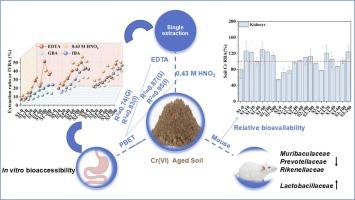Integrated assessment of chromium exposure risk from agricultural soils using chemical extraction, in vitro simulation, and mouse bioassay
IF 11.3
1区 环境科学与生态学
Q1 ENGINEERING, ENVIRONMENTAL
引用次数: 0
Abstract
Chromium (Cr) contamination in soil poses significant human health risks due to its toxicity and environmental persistence. In this study, the bioaccessibility of Cr from three aged agricultural soils was assessed using an in vitro (physiologically based extraction test, PBET) method. Simultaneously, single extraction methods (0.43 M HNO3 and EDTA) and in vivo (mouse model) bioassay were used to assess the health effects of Cr exposure. The results showed that Cr bioaccessibility in the gastric phase ranged from 0.7 % to 21.7 %, and was 1.3–1.8 folds higher in the small intestinal phase. Among the three soils, the weakly alkaline soil exhibited the highest bioaccessibility in both phases. Significant correlations (R2 = 0.74–0.95) were found between extractable Cr (%) and Cr bioaccessibility, particularly for 0.43 M HNO3. In vivo bioassays determined relative bioavailability (based on kidneys or liver), absolute bioavailability, and Cr concentration in tissues, revealing that Cr tended to be excreted rather than accumulated in tissues. Additionally, Cr exposure altered gut microbiota composition, notably increasing Lactobacillaceae while decreasing Muribaculaceae, Prevotellaceae and Rikenellaceae. This study highlighted that single extraction methods could predict in vitro bioaccessibility, which facilitates the rapid and accurate assessment of risks from oral intake of Cr-contaminated soils.

利用化学萃取、体外模拟和小鼠生物测定对农业土壤中铬暴露风险的综合评估
土壤中的铬(Cr)污染由于其毒性和环境持久性而对人类健康构成重大威胁。本研究采用体外生理提取法(PBET)对3种老化农业土壤中铬的生物可及性进行了评价。同时,采用单次提取法(0.43 M HNO3和EDTA)和体内(小鼠模型)生物测定法评估铬暴露对健康的影响。结果表明,Cr在胃期的生物可及性为0.7% ~ 21.7%,小肠期的可及性为1.3 ~ 1.8倍。在3种土壤中,弱碱性土壤在两个阶段的生物可达性均最高。可提取Cr(%)与Cr的生物可及性之间存在显著相关(R2 = 0.74 ~ 0.95),特别是在0.43 M HNO3条件下。体内生物测定测定了相对生物利用度(基于肾脏或肝脏)、绝对生物利用度和组织中的Cr浓度,揭示了Cr倾向于排泄而不是在组织中积累。此外,铬暴露改变了肠道菌群组成,显著增加了乳酸杆菌科,减少了Muribaculaceae, Prevotellaceae和Rikenellaceae。本研究强调,单一提取方法可以预测体外生物可及性,有助于快速准确地评估口服铬污染土壤的风险。
本文章由计算机程序翻译,如有差异,请以英文原文为准。
求助全文
约1分钟内获得全文
求助全文
来源期刊

Journal of Hazardous Materials
工程技术-工程:环境
CiteScore
25.40
自引率
5.90%
发文量
3059
审稿时长
58 days
期刊介绍:
The Journal of Hazardous Materials serves as a global platform for promoting cutting-edge research in the field of Environmental Science and Engineering. Our publication features a wide range of articles, including full-length research papers, review articles, and perspectives, with the aim of enhancing our understanding of the dangers and risks associated with various materials concerning public health and the environment. It is important to note that the term "environmental contaminants" refers specifically to substances that pose hazardous effects through contamination, while excluding those that do not have such impacts on the environment or human health. Moreover, we emphasize the distinction between wastes and hazardous materials in order to provide further clarity on the scope of the journal. We have a keen interest in exploring specific compounds and microbial agents that have adverse effects on the environment.
 求助内容:
求助内容: 应助结果提醒方式:
应助结果提醒方式:


